Microrelief Associated with Gas Emission Craters: Remote-Sensing and Field-Based Study
Abstract
:1. Introduction
2. Materials and Methods
3. Results
3.1. GEC-2
3.1.1. Dating of GEC Formation
3.1.2. Field Results
3.1.3. Remote-Sensing Results
3.2. AntGEC
3.2.1. Dating of GEC Formation
3.2.2. Field Results
3.2.3. Remote-Sensing Results
4. Discussion
- Lithological composition of ejected deposits. Only in case of large blocks of icy permafrost or pure ice, the impact pit would not be filled with thawed deposits and preserved as a negative microform; when the blocks of less icy frozen deposits are ejected, the impact pits are masked by thawed material. In addition, cryolithological structure of the geological section in the mound-predecessor probably determines the size of the ejected blocks. Small, fragmented blocks of ejected deposits formed in the initially thin-layered sediments as described in GEC-1 [2] probably do not lead to the ejection of blocks large enough to form impact hollows;
- Differences in the structure of vegetation cover around GEC. Most pronounced are impact hollows on surfaces covered with moss–lichen–grass vegetation. In shrubby areas, firstly, willows could partially cushion a shock effect of falling blocks as presented on photographs in [1] (p. 14), and secondly, impact forms may not be detected when overshadowed by shrubs.
5. Conclusions
- Both positive and negative microforms of the relief associated with GEC formation could be found around GECs.
- Positive microforms around GECs are characteristic for all craters and consist of the ejected frozen deposits, now thawed. These deposits either form a single parapet, or isolated piles and ridges 0.2–3.5 m in diameter and 0.1–0.8 m in height. Preservation of positive microforms is determined by lithological composition of ejected deposits and their resistance to erosion by rain and meltwater. Microforms composed of loam as compared to sandy loam and sand preserve better.
- Negative microforms were found only around GEC-2, AntGEC and SeYkhGEC, and comprise rounded hollows up to 13 m in diameter and up to 1.5 m in depth, surrounded by an edging of extruded deposits. In most cases, these hollows are filled with water except for hollows on slopes or edges drained by erosion.
- While crater walls are retreating, the closest to the crater rim hollows are first drained and then engulfed by the crater lake. Piles and ridges are eroded and fall into the crater lake. Interpretation of multi-temporal imagery allows reconstruction of initial position, size and number of piles and hollows now inundated and thus estimate the amount and iciness of ejected material.
- We suppose that data obtained by analysis of imagery, photographs and field survey provides sufficient evidence in favor of the hypothesis that the hollows around GECs are impact microforms associated with a hit from large blocks of frozen deposits.
- RSD application made it possible to identify impact hollows at a distance of up to 293 m from the GEC-2 AMP, which we did not expect based on previous studies and thus did not observe in field. We consider the size of the scattering zones to serve as an indicator of the “eruption” energy. This information can be used in future in modeling the mechanism of GECs formation.
- During field surveys of new GECs, the search zone for traces of ejected material and possible impact hollows should be expanded to at least 300 m unless there are any other indications of the range by an analysis of operational very-high resolution satellite imagery.
- Thus, it has been established that the area of the relief-forming effect of GECs (risk zones) extends far wider than the crater with its parapet alone which should be taken into consideration when planning further studies and estimating risks of allocating economic infrastructure and settlements (including temporary camp sites of the indigenous tundra population) close to predicted craters.
Author Contributions
Acknowledgments
Conflicts of Interest
References
- Leibman, M.O.; Plekhanov, A.V. The Yamal gas emission crater: Results of preliminary survey. KholodOK 2014, 2, 9–15. (In Russian) [Google Scholar]
- Leibman, M.O.; Kizyakov, A.I.; Plehanov, A.V.; Streletskaya, I.D. New permafrost feature: Deep crater in Central Yamal, West Siberia, Russia as a response to local climate fluctuations. Geogr. Environ. Sustain. 2014, 4, 68–80. [Google Scholar] [CrossRef]
- Khilimonyuk, V.Z.; Ospennikov, E.N.; Buldovich, S.N.; Gunar, A.Y.; Gorshkov, E.I. Geocryological conditions of Yamal crater location. In Proceedings of the Fifth Conference of Russian Geocryologists, Moscow, Russia, 14–17 June 2016; University Book: Moscow, Russia, 2016; Volume 2, pp. 245–255. (In Russian). [Google Scholar]
- Epov, M.I.; Eltsov, I.N.; Olenchenko, V.V.; Potapov, V.V.; Kushnarenko, O.N.; Plotnikov, A.E.; Sinitsky, A.I. The Bermuda Triangle of the Yamal Peninsula. Nauka Perv. Ruk 2014, 5, 14–23. (In Russian) [Google Scholar]
- Olenchenko, V.V.; Sinitsky, A.I.; Antonov, E.Y.; Eltsov, I.N.; Kushnarenko, O.N.; Plotnikov, A.E.; Potapov, V.V.; Epov, M.I. Results of geophysical researches of the area of new geological formation “Yamal crater”. Kriosf. Zemli 2015, XIX4, 94–106. [Google Scholar]
- Sizov, O.S. Remote sensing data analysis of the consequences of gas releases in the north of Western Siberia. Geomatica 2015, 1, 53–68. (In Russian) [Google Scholar]
- Bogoyavlenskiy, V.I.; Sizov, O.S.; Bogoyavlenskiy, I.V.; Nikonov, R.A. Remote detection of surface gas releases in the Arctic: The Yamal Peninsula. Arct. Ecol. Econ. 2016, 3, 4–15. (In Russian) [Google Scholar]
- Kizyakov, A.I.; Sonyushkin, A.V.; Leibman, M.O.; Zimin, M.V.; Khomutov, A.V. Geomorphological conditions of the gas-emission crater and its dynamics in Central Yamal. Kriosf. Zemli 2015, 2, 13–22. [Google Scholar]
- Streletskaya, I.D.; Leibman, M.O.; Kizyakov, A.I.; Oblogov, G.E.; Vasiliev, A.A.; Khomutov, A.V.; Dvornikov, Y.A. Ground Ice and its Role in the Formation of Gas-Emission Crater in the Yamal Peninsula. Mosc. Univ. Bull. Ser. 5 Geogr. 2017, 2, 91–99. (In Russian) [Google Scholar]
- Leibman, M.O.; Dvornikov, Y.A.; Khomutov, A.V.; Babkin, E.M.; Babkina, E.A.; Vanshtein, B.G.; Kizyakov, A.I.; Oblogov, G.E.; Semenov, P.B.; Streletskaya, I.D. Hydro-chemical features of water in lakes and gas-emission craters embedded in the marine deposits of West-Siberian north. In Geology of Seas and Oceans, Proceedings of the XXII International Conference on Marine Geology, Russia, Moscow, 20–24 November 2017; Lisitzin, A.P., Politova, N.V., Shevchenko, V.P., Eds.; IO RAS: Moscow, Russia, 2017; Volume IV, pp. 117–121. (In Russian) [Google Scholar]
- Kizyakov, A.I.; Sonyushkin, A.V.; Khomutov, A.V.; Dvornikov, Y.A.; Leibman, M.O. Assessment of the relief-forming effect of the Antipayuta gas emission crater formation using satellite stereo pairs. Curr. Probl. Remote Sens. Earth Space 2017, 4, 67–75. [Google Scholar] [CrossRef]
- Kizyakov, A.; Zimin, M.; Sonyushkin, A.; Dvornikov, Y.; Khomutov, A.; Leibman, M. Comparison of Gas Emission Crater Geomorphodynamics on Yamal and Gydan Peninsulas (Russia), Based on Repeat Very-High-Resolution Stereopairs. Remote Sens. 2017, 9, 1023. [Google Scholar] [CrossRef]
- TV and Radio Company Yamal-Region. Available online: http://yamal-region.tv/news/26092/ (accessed on 4 April 2018).
- Dubikov, G.I. Composition and Cryogenic Structure of the Western Siberia Permafrost; GEOS: Moscow, Russia, 2002; p. 246. (In Russian) [Google Scholar]
- Badu, Y.B.; Trofimov, V.T.; Vasilchuk, Y.K. The main patterns of distribution and types of tabular ground ice in the northern part of the West Siberian Plate. In Tabular Ground Ice in Cryolithozone; Popov, A.I., Ed.; Permafrost Institute: Yakutsk, Russia, 1982; pp. 13–24. (In Russian) [Google Scholar]
- Streletskaya, I.D.; Leibman, M.O. Cryogeochemical interrelation of massive ground ice, cryopegs, and enclosing deposits of Central Yamal. Kriosf. Zemli 2002, 4, 15–24. (In Russian) [Google Scholar]
- Vasilchuk, Y.K. Tabular ground ice. In Cryosphere of Oil and Gas Condensate Fields of the Yamal Peninsula; Badu, Y.B., Gafarov, E.A., Podborny, E.E., Eds.; Cryosphere of the Bovanenkovskoye Oil and Gas Condensate Field; Gazprom Expo: Moscow, Russia, 2013; Volume 2, pp. 284–317. (In Russian) [Google Scholar]
- Ananyeva, G.V. Specific features of the engineering-geocryological conditions of the northern section of the Obskaya-Bevanenkovo railway under design. In Results of Fundamental Research of the Earth Cryosphere in Arctic and Subarctic; Nauka: Novosibirsk, Russia, 1997; pp. 116–123. (In Russian) [Google Scholar]
- Vasiliev, A.A.; Streletskaya, I.D.; Melnikov, V.P.; Oblogov, G.E. Methane in Ground Ice and Frozen Quaternary Deposits of Western Yamal. Dokl. Earth Sci. 2015, 465, 1289–1292. [Google Scholar] [CrossRef]
- Kraev, G.; Schulze, E.-D.; Yurova, A.; Kholodov, A.; Chuvilin, E.; Rivkina, E. Cryogenic Displacement and Accumulation of Biogenic Methane in Frozen Soils. Atmosphere 2017, 8, 105. [Google Scholar] [CrossRef]
- Yakushev, V.S. Natural Gas and Gas Hydrates in Cryolithozone; VNIIGAS: Moscow, Russia, 2009; p. 192. (In Russian) [Google Scholar]
- Bogoyavlenskiy, V.I.; Bogoyavlenskiy, I.V.; Nikonov, R.A. Results of aerial, space and field investigations of large gas blowouts near Bovanenkovo field on Yamal Peninsula. Arct. Ecol. Econ. 2017, 3, 4–17. [Google Scholar] [CrossRef]
- Project “Geoportal of the Lomonosov Moscow State University”. Available online: http://www.geogr.msu.ru/science/projects/geoportal/about/ (accessed on 15 January 2018).
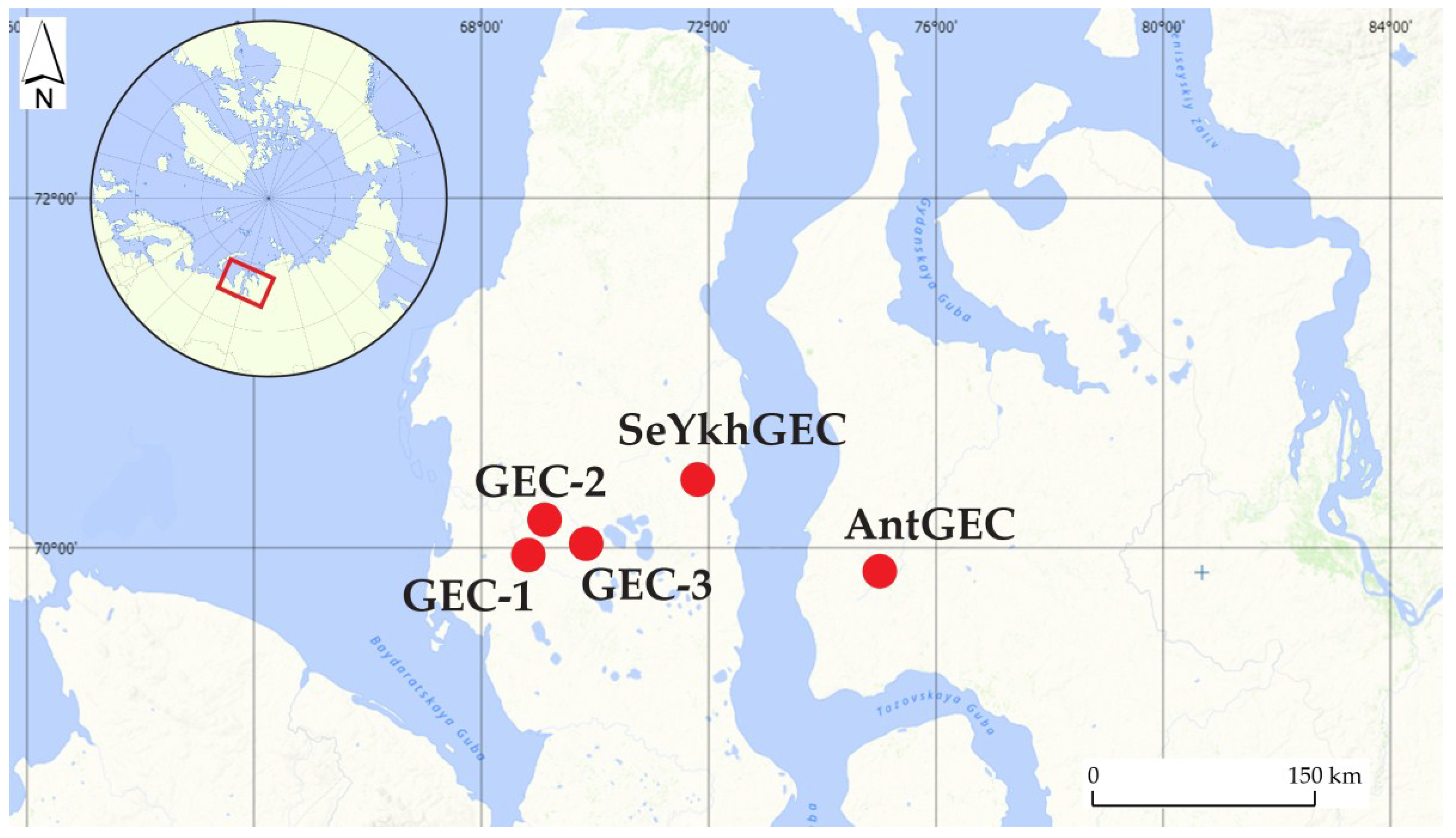
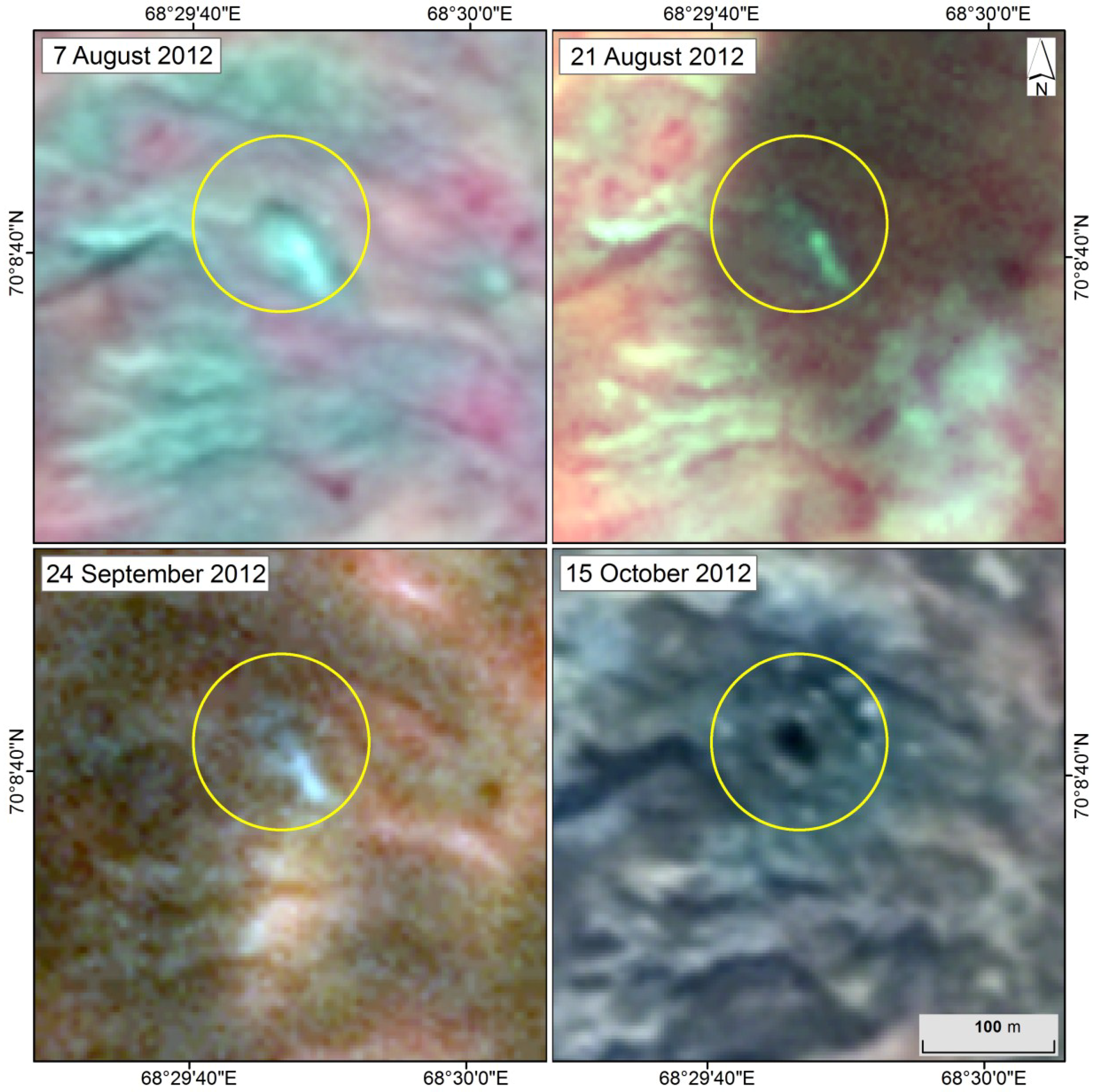

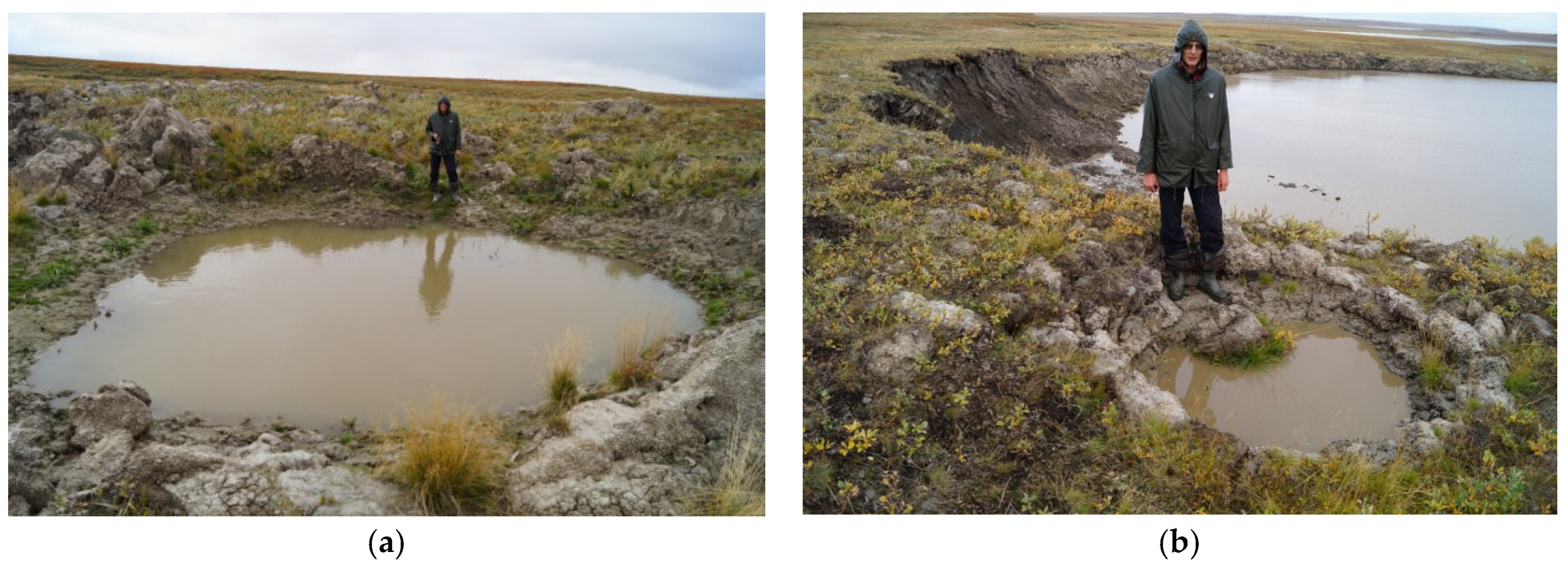
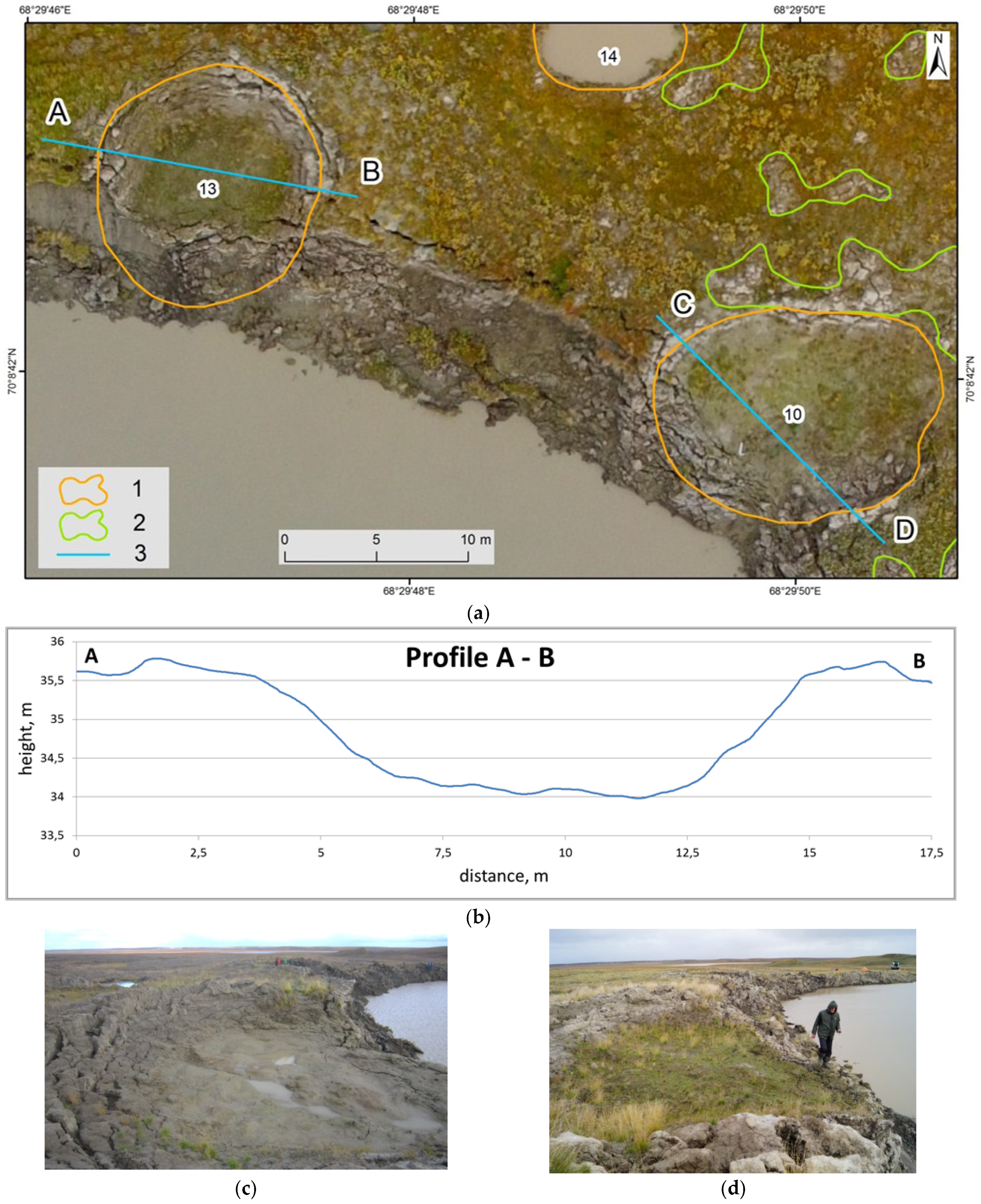
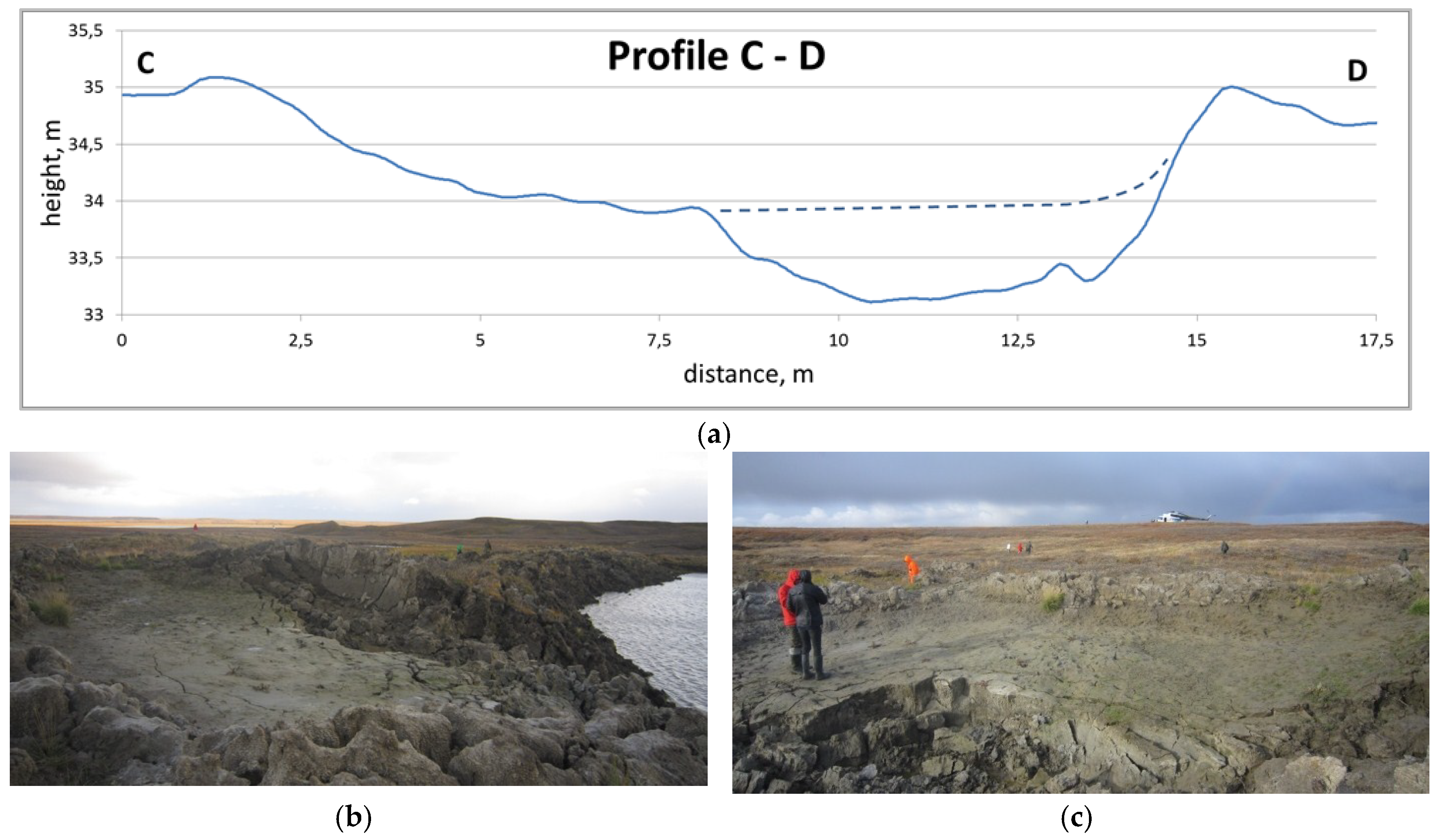
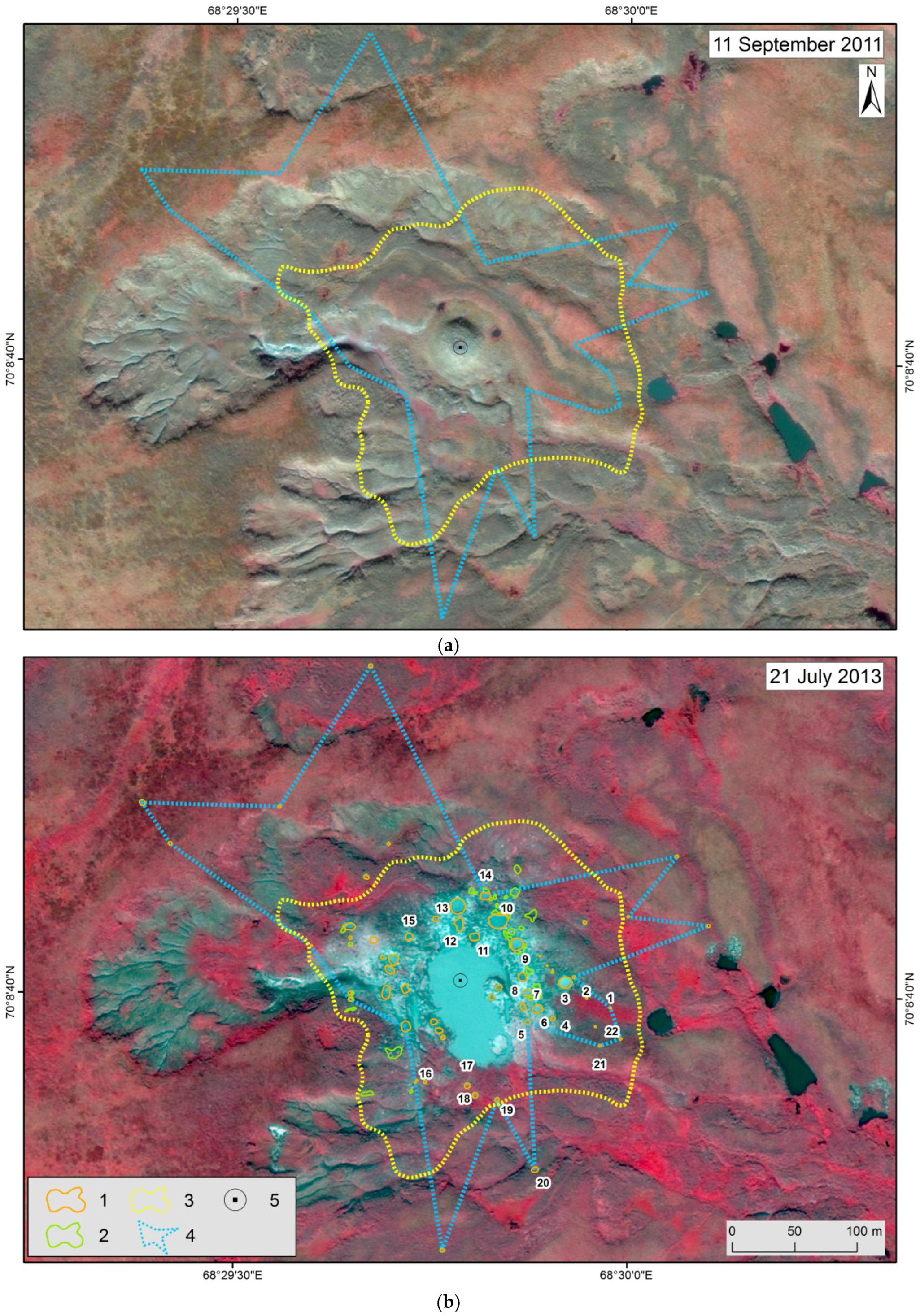
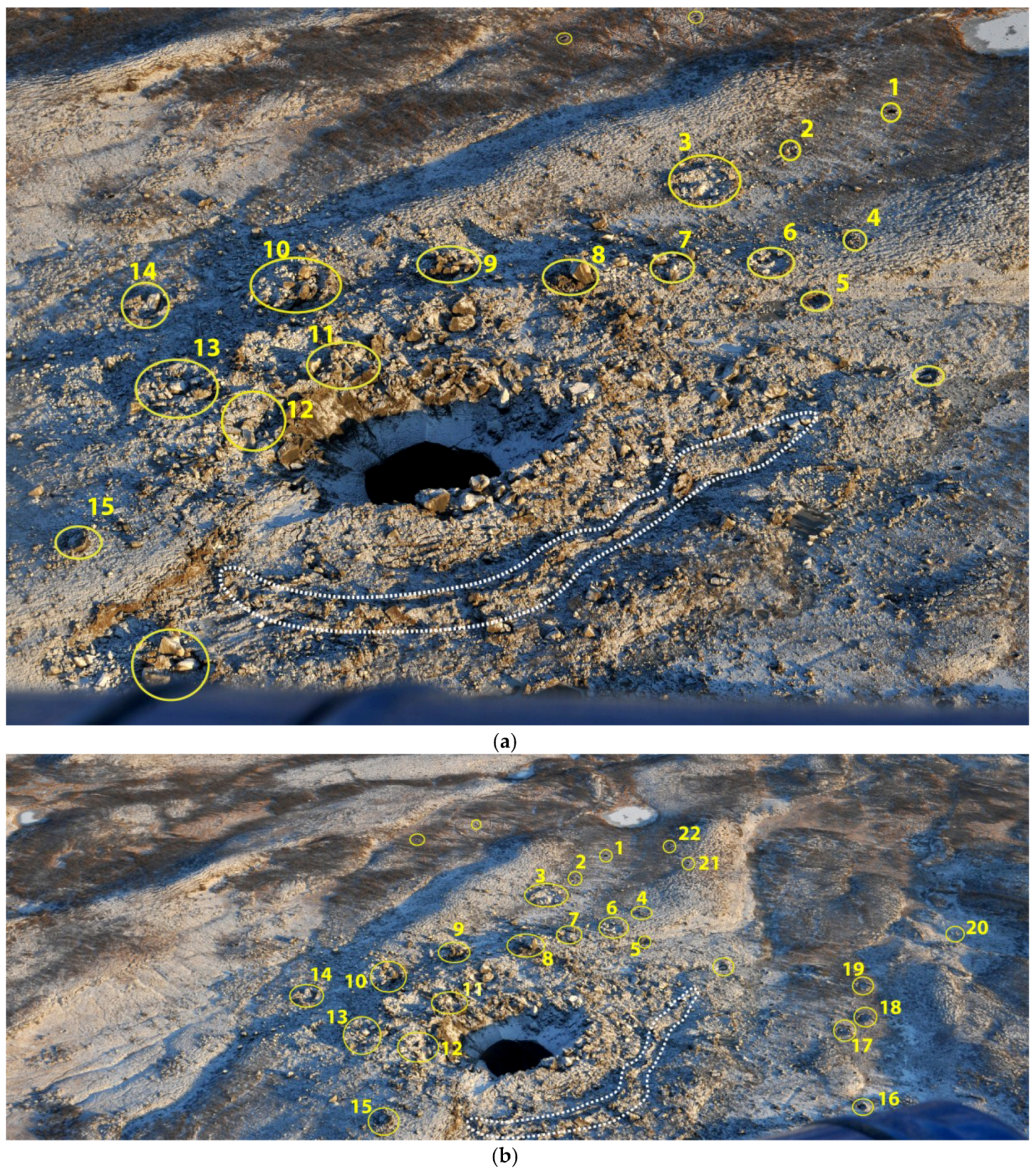
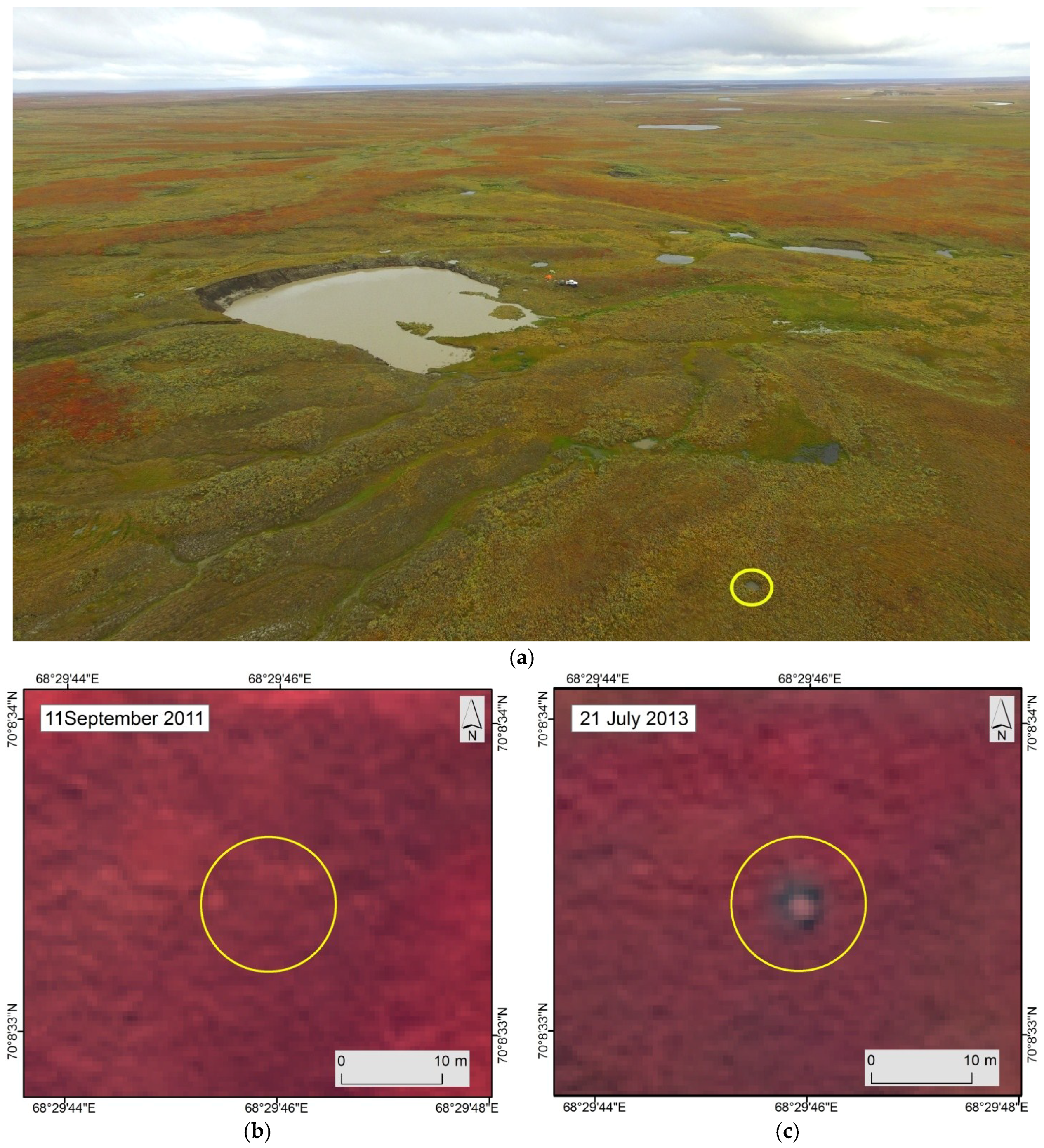
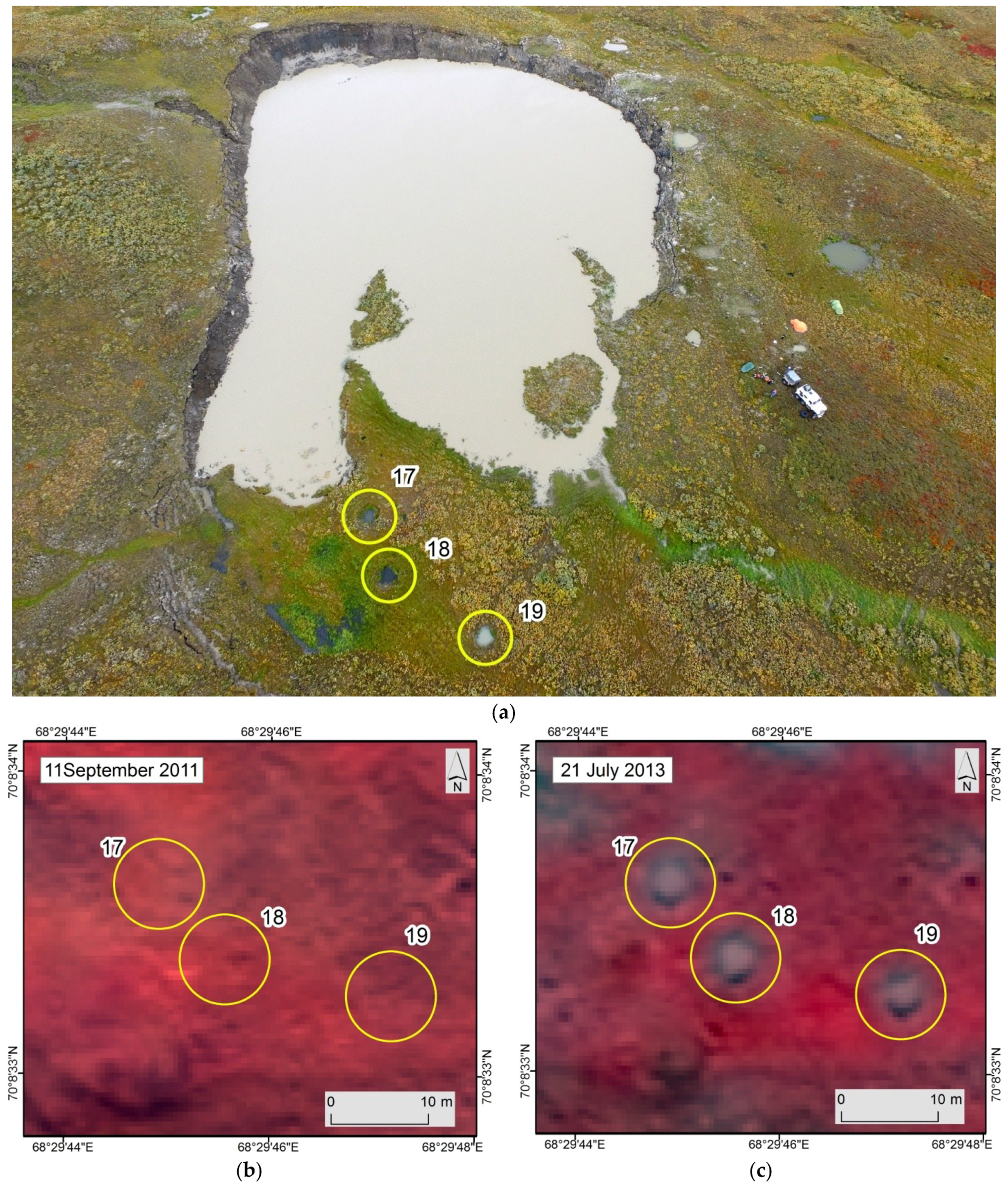
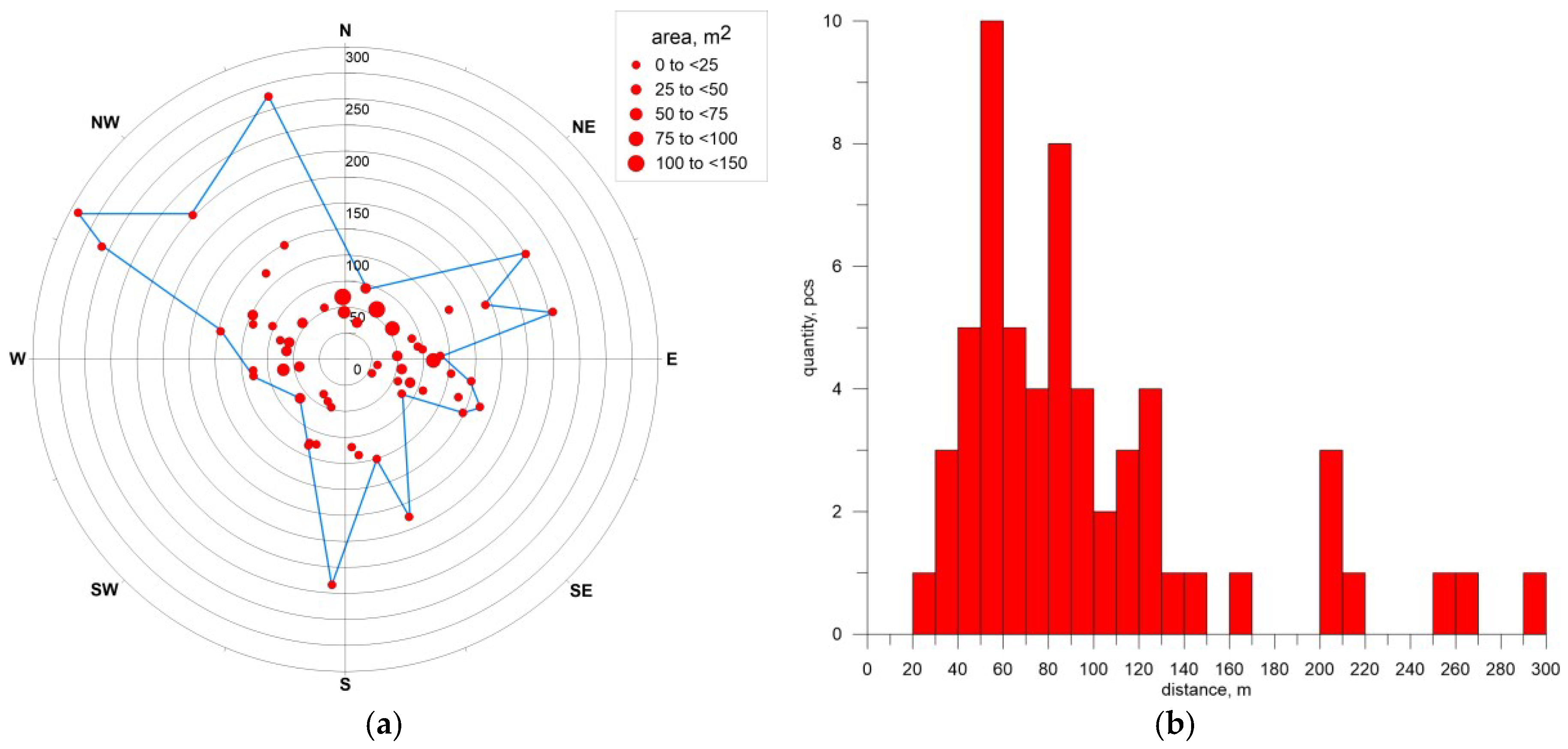
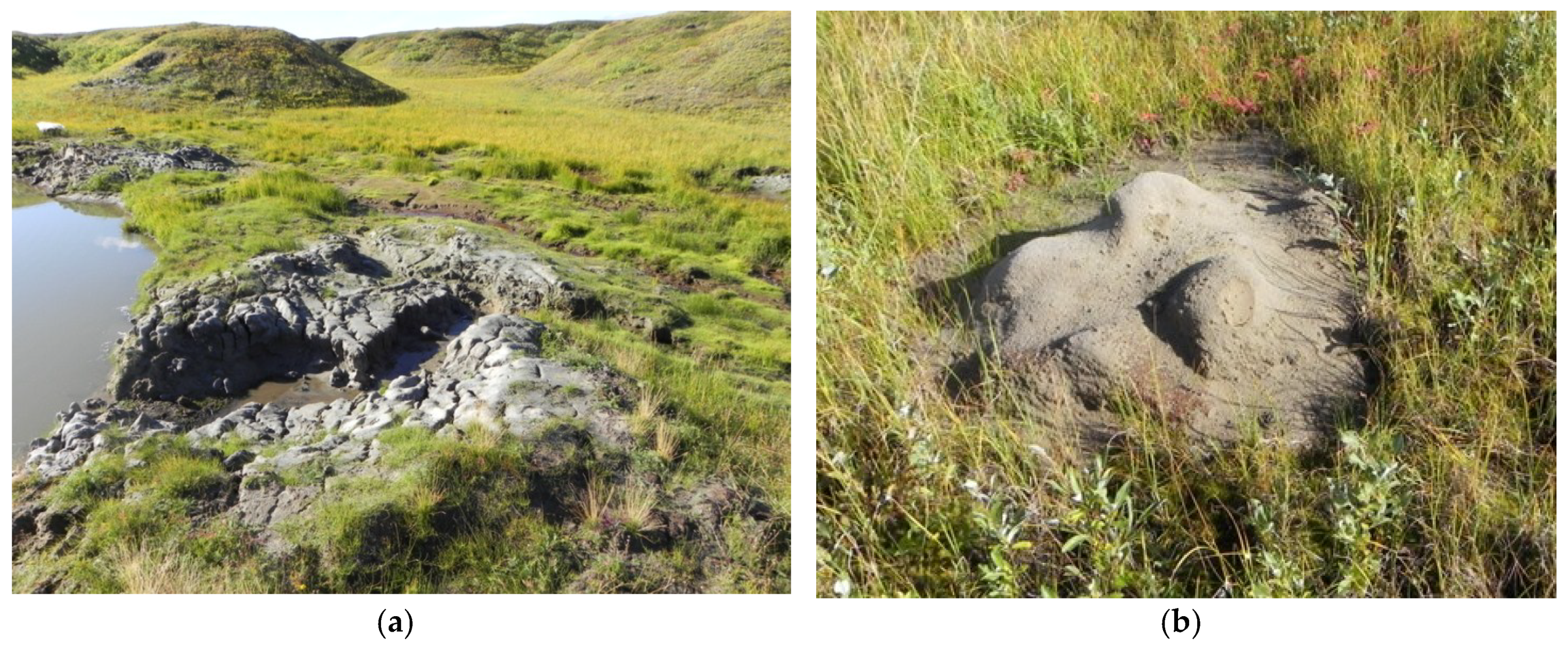

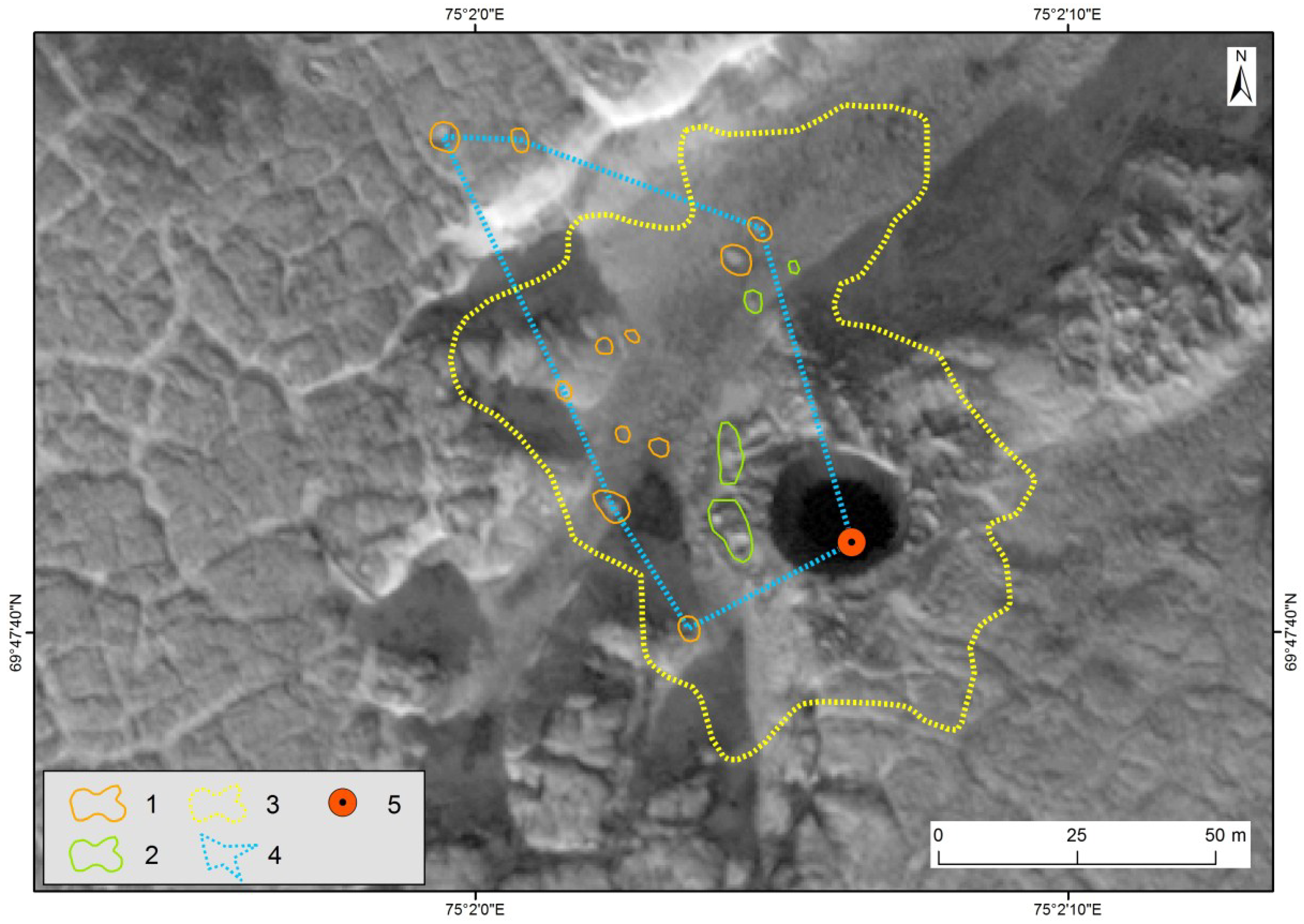

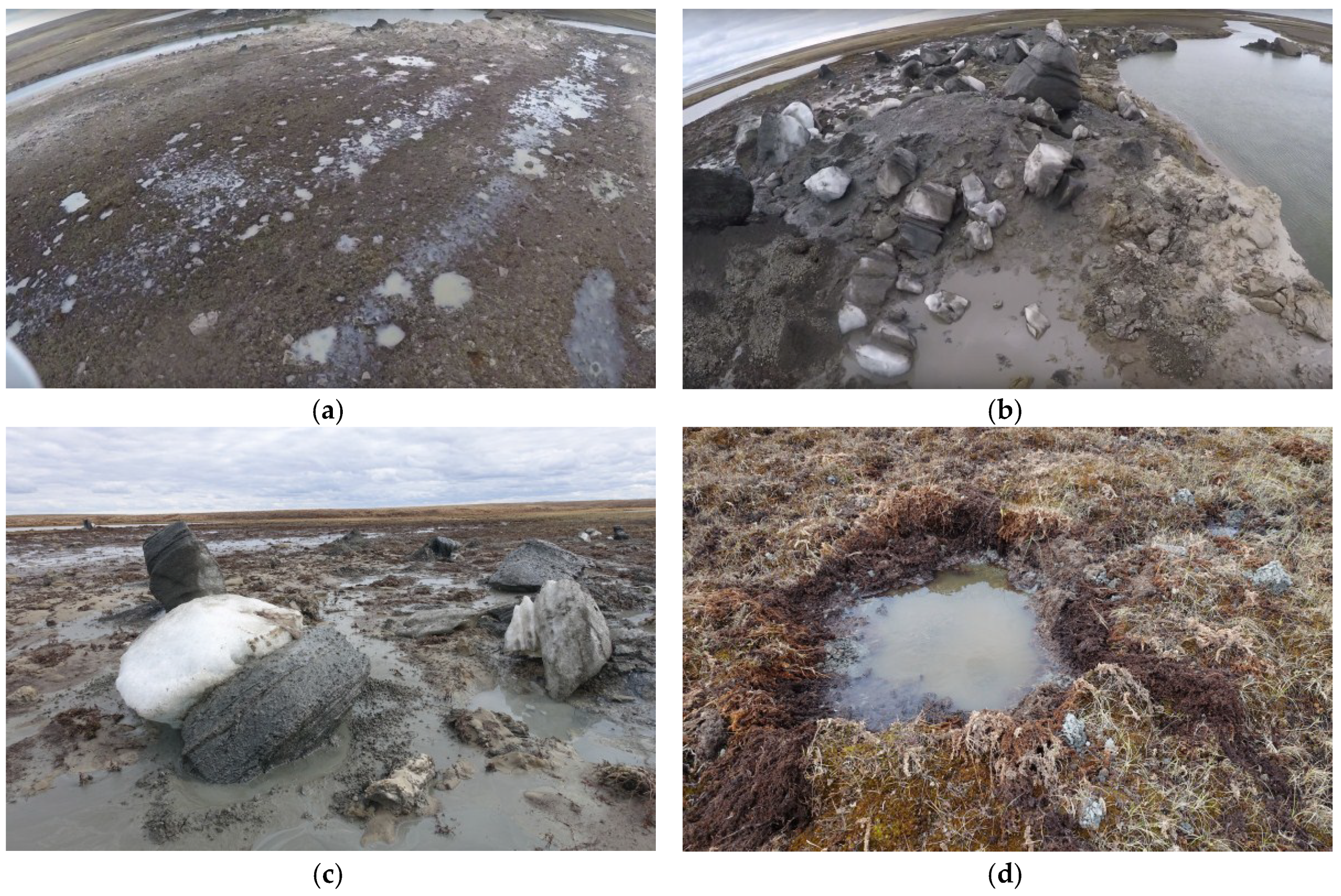
| Gas Emission Crater | Latitude (N) | Longitude (E) |
|---|---|---|
| GEC-1 | 69.9711 | 68.3702 |
| GEC-2 | 70.1446 | 68.4959 |
| GEC-3 | 70.0624 | 69.1002 |
| SeYkhGEC | 70.3021 | 71.7458 |
| AntGEC | 69.7947 | 75.035 |
| Sensor | Date | Pan Ground Sample Distance, m | Key-Site |
|---|---|---|---|
| WorldView-2 1 | 11 September 2011 | 0.5 | GEC-2 |
| WorldView-2 1 | 21 July 2013 | 0.5 | |
| SPOT5 2 | 07 August 2012 | 2.5 | |
| SPOT5 2 | 21 August 2012 | 5.0 | |
| SPOT5 2 | 24 September 2012 | 5.5 | |
| SPOT5 2 | 15 October 2012 | 5.3 | |
| SPOT5 2 | 22 October 2012 | 5.0 | |
| UAV | 07 September 2017 | 0.04 | |
| WorldView-2 | 21 August 2013 | 0.5 | AntGEC |
| WorldView-1 | 11 October 2014 | 0.6 |
| Description of Microrelief | Examples in the Photographs | |
|---|---|---|
| Hollows without observed impactors, empty, later filled with water |  |  |
| Hollow 1 in Figure 7 and Figure 8 | Hollow 5 in Figure 7 and Figure 8 | |
| Hollows with observed impactors, later filled with water |  |  |
| Hollow 3 in Figure 7 and Figure 8 | Hollow 14 in Figure 7 and Figure 8 | |
 | ||
| Hollow 10 in Figure 7 and Figure 8 | ||
| Blocks (impactors), later appeared as hollows filled with water |  |  |
| Hollow 8 in Figure 7 and Figure 8 | Hollow 9 in Figure 7 and Figure 8 | |
| A ridge of ejected material along the SE side of GEC-2, the shadow of which is clearly visible in the photograph |  | |
| Bank outlined by a white dashed line in Figure 8 | ||
| Parameters of Material Scattering | GEC-2 | AntGEC |
|---|---|---|
| max distance of impact hollows relative to the AMP, m | 293 | 104 |
| min distance of impact hollows relative to the AMP, m | 28.6 | 33.3 |
| max impact hollow area, m2 | 143.4 | 26.5 |
| min impact hollow area, m2 | 0.04 | 0.04 |
| zone A area, m2 | 62080 | 3350 |
| zone B area, m2 | 50250 | 7170 |
© 2018 by the authors. Licensee MDPI, Basel, Switzerland. This article is an open access article distributed under the terms and conditions of the Creative Commons Attribution (CC BY) license (http://creativecommons.org/licenses/by/4.0/).
Share and Cite
Kizyakov, A.; Khomutov, A.; Zimin, M.; Khairullin, R.; Babkina, E.; Dvornikov, Y.; Leibman, M. Microrelief Associated with Gas Emission Craters: Remote-Sensing and Field-Based Study. Remote Sens. 2018, 10, 677. https://doi.org/10.3390/rs10050677
Kizyakov A, Khomutov A, Zimin M, Khairullin R, Babkina E, Dvornikov Y, Leibman M. Microrelief Associated with Gas Emission Craters: Remote-Sensing and Field-Based Study. Remote Sensing. 2018; 10(5):677. https://doi.org/10.3390/rs10050677
Chicago/Turabian StyleKizyakov, Alexander, Artem Khomutov, Mikhail Zimin, Rustam Khairullin, Elena Babkina, Yury Dvornikov, and Marina Leibman. 2018. "Microrelief Associated with Gas Emission Craters: Remote-Sensing and Field-Based Study" Remote Sensing 10, no. 5: 677. https://doi.org/10.3390/rs10050677






